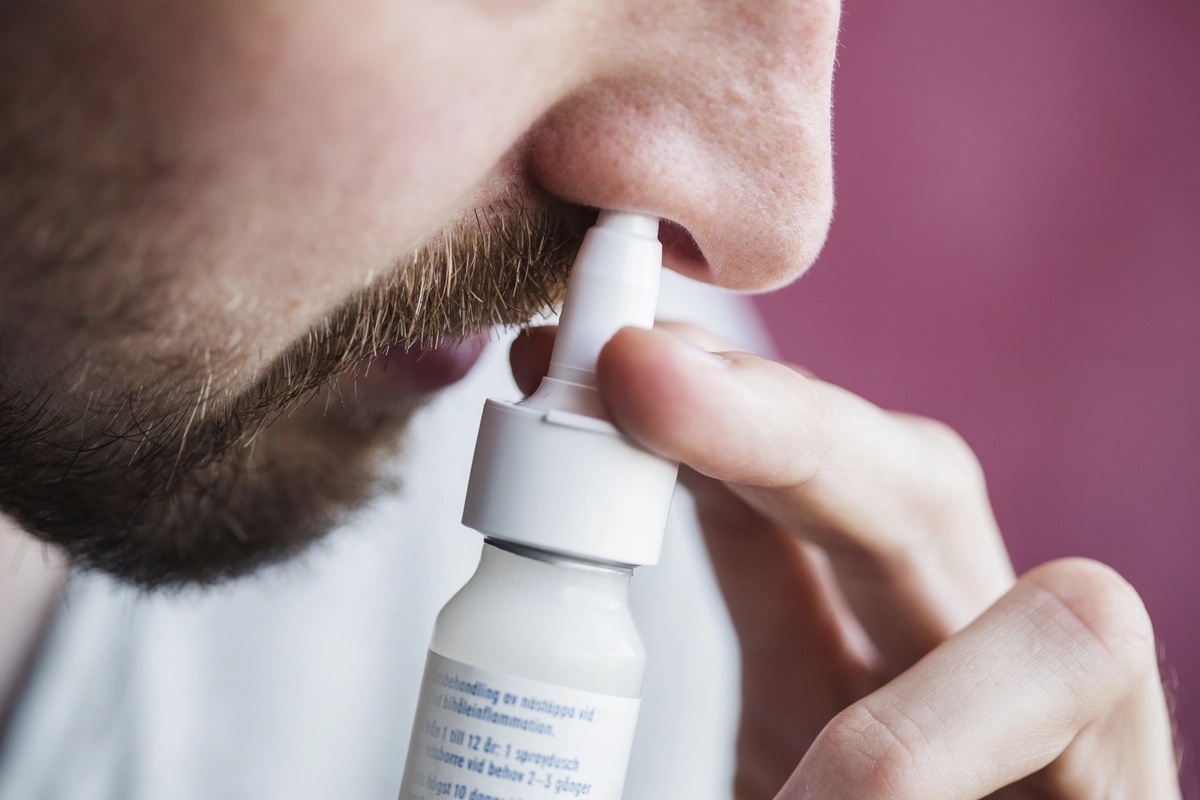Inhalants: Addiction Symptoms, Causes, & Treatment Options


Inhalant addiction is a growing cause for concern, especially among adolescents — and we empathize with the disruptions it can bring to daily life. However, you’re not alone, and treatment is available to help you heal and recover. Learn more about the symptoms and treatment options for inhalant addiction, and call The Forge Recovery Center today if you or a loved one are in need of professional support.
What Are Inhalants?
Inhalants are substances that produce chemical vapors which, when inhaled, can cause mind-altering effects. These substances are typically found in household products like cleaning fluids, aerosol sprays, and glue. When inhaled, inhalants can lead to a rapid high due to their quick absorption into the bloodstream through the lungs. However, inhalant abuse can have serious consequences, including damage to the brain, heart, liver, kidneys, and lungs. It is important to be aware of the dangers associated with inhalant use and seek help if needed.
Types of Inhalants
Inhalants include volatile solvents like paint thinners and glue, aerosols such as spray paints and deodorant sprays, and gasses like nitrous oxide and butane.
Inhaling volatile solvents can lead to effects such as dizziness, nausea, and impaired coordination. Aerosols, on the other hand, can cause lightheadedness, hallucinations, and even sudden death due to heart failure. When it comes to gasses, they can induce euphoria, but prolonged use may result in memory loss and nerve damage.
Here are some examples of common household products that fall under each type of inhalant:
Volatile Solvents: Paint thinners, nail polish removers
Aerosols: Spray paints, air fresheners
Gasses: Butane lighters, propane tanks
Using inhalants may seem harmless at first glance, but it's crucial to understand the serious risks associated with them. By educating yourself about the dangers of inhalant abuse, you can protect yourself and your loved ones from potential harm.

What Is Inhalant Addiction?
Inhalant addiction refers to the compulsive use of substances that are inhaled to produce mind-altering effects. These substances, such as aerosol sprays, cleaning fluids, and paint thinners, are typically not meant for human consumption but are abused for their psychoactive properties. Inhalant abuse can lead to serious health consequences, including damage to the brain, heart, liver, and other organs. It is important for individuals struggling with inhalant addiction to seek professional help to overcome this harmful and potentially deadly habit.
Are You Struggling with Mental Health or Addiction?
We Can Help. Call Us Now!
CALL: 877-839-1772
Symptoms of Inhalant Addiction
Inhalant addiction carries a range of behavioral and physical symptoms. By knowing the signs, you can get the help that you or a loved one need. Here’s an overview of the symptoms to be aware of:
Behavioral Symptoms
When observing someone struggling with inhalant addiction, you may notice erratic behavior and mood swings. You might also see social withdrawal and neglect of responsibilities.
Physical Symptoms
Inhalant addiction can manifest physically through various signs. You could observe frequent headaches, nausea, and dizziness. You may also notice a lack of coordination and slurred speech.
Skin Changes
One common physical symptom of inhalant addiction is skin changes. These alterations may include dry, cracked skin or rashes due to chemical exposure.
Eye Irritation
Another physical symptom to be aware of is eye irritation. This can present as redness, itching, or watering of the eyes due to the harmful effects of inhalants.
Inhalant Addiction Treatment Options
Treatment for inhalant addiction starts with detoxification, before moving on to treatment at an inpatient or outpatient treatment center. Aftercare is the last stage. and a crucial step to help those in recovery maintain long-term sobriety. Here’s how the treatment process works:
Detoxification
When you decide to seek treatment for inhalant addiction, the first step is detoxification. This process involves clearing your body of toxins from inhalant use. It's crucial to undergo detox in a supervised medical setting to manage withdrawal symptoms effectively.
Detox for inhalant addiction typically lasts for a few days. During this time, medical professionals monitor you closely to ensure your safety and provide the necessary support. They may administer medications to alleviate withdrawal symptoms and make your detox experience more comfortable.
Inpatient Care
Inpatient care for inhalant addiction offers intensive treatment in a residential facility. You will reside at the center full-time, receiving round-the-clock care and support. This level of care is beneficial for those with severe addiction or co-occurring mental health issues.
Inpatient programs provide a structured environment where you can focus solely on recovery. Therapy sessions, group activities, and educational workshops are part of the comprehensive treatment plan. You will also have access to medical professionals and counselors throughout the program.
Outpatient Care
Outpatient care for inhalant addiction allows you to live at home while attending scheduled treatment sessions. This option provides flexibility for those with work or family commitments. You can continue your daily responsibilities while receiving support for recovery.
Outpatient programs offer therapy, counseling, and support groups to help you address underlying issues contributing to addiction. You will also learn coping skills and strategies to prevent relapse. The frequency of sessions varies based on individual needs and progress.
Aftercare
After completing a formal treatment program, aftercare is essential for maintaining sobriety from inhalants. You can engage in ongoing therapy, support groups, or counseling sessions as part of aftercare services. These resources help reinforce relapse prevention strategies and provide continued support as you transition back into daily life.
Establishing a strong support network through aftercare is crucial in preventing relapse and maintaining long-term recovery from inhalant addiction. By staying connected with peers who understand your journey, seeking professional guidance when needed, and practicing healthy coping mechanisms, you can build a solid foundation for a substance-free life.
Are You Struggling with Mental Health or Addiction?
We Can Help. Call Us Now!
CALL: 877-839-1772
Therapies for Inhalant Addiction
Specialized therapies, such as pharmacologic interventions and behavioral treatments, are particularly effective for those struggling with inhalant addiction. Let’s explore these therapies further:
Pharmacologic Interventions
When addressing inhalant addiction, pharmacologic interventions play a crucial role in managing withdrawal symptoms. Medications such as benzodiazepines can help alleviate anxiety and seizures during the detoxification process. Naltrexone may be prescribed to reduce cravings and prevent relapse by blocking the effects of inhalants.
To assist in overcoming the challenges of inhalant addiction, healthcare providers might recommend medications like antidepressants to manage co-occurring mental health conditions. These medications can help stabilize mood swings and address underlying issues contributing to substance abuse. Medication-assisted treatment can significantly enhance recovery outcomes by reducing withdrawal discomfort.
Behavioral Therapies
Behavioral interventions are essential components of treating inhalant addiction effectively. Cognitive behavioral therapy (CBT) focuses on identifying and modifying negative thought patterns and behaviors associated with substance use. This therapy equips you with coping strategies to manage triggers and cravings, promoting long-term abstinence.
Incorporating contingency management into your treatment plan can provide positive reinforcement for sobriety milestones. By rewarding abstinence with incentives like vouchers or privileges, this approach reinforces healthy behaviors and motivates you to stay committed to recovery. Family therapy can improve communication, rebuild relationships, and create a supportive environment for sustained sobriety.

Causes of Inhalant Addiction
Inhalant addiction typically stems from a combination of factors, including your accessibility to inhalants, the power of peer pressure, and being unaware of how addictive inhalants are. Here’s a summary of the primary drivers of inhalant addiction:
Availability
When it comes to inhalant addiction, the easy availability of inhalants in common household products can be a significant factor. Household items like aerosol sprays, cleaning fluids, and paint thinners are easily accessible.
Inhalants are also found in products like glue, nail polish remover, and gasoline, making them readily available even to teenagers. The easy access to these substances increases the risk of experimentation and subsequent addiction.
Peer Pressure
Peer pressure plays a crucial role in inhalant addiction among young individuals. When your friends or peers engage in inhalant use, you might feel pressured to join them to fit in or be accepted within your social circle.
The desire to be part of a group can lead you to experiment with inhalants, gradually developing into an addiction. Peer influence can significantly impact your decision-making process regarding substance use.
Coping Mechanism
For some individuals, using inhalants becomes a coping mechanism for dealing with stress, anxiety, or other emotional issues. When facing challenging situations or emotions, turning to inhalants may provide a temporary escape or relief from negative feelings.
Using inhalants as a coping mechanism can quickly escalate into addiction as you rely more on these substances to manage your emotions or cope with difficulties in life.
Lack of Awareness
Lack of awareness about the dangers and risks associated with inhalant use is another contributing factor to addiction. Without proper education on the harmful effects of inhaling these substances, you may underestimate the potential consequences.
Many individuals, especially young people, may not fully understand the addictive nature of inhalants and the damage they can cause to the brain and body over time. This lack of awareness can lead to continued use and eventual addiction.
Are You Struggling with Mental Health or Addiction?
We Can Help. Call Us Now!
CALL: 877-839-1772
Consequences of Inhalant Addiction
If left untreated, inhalant addiction can lead to detrimental consequences to your health, and mental well-being, and even carries social repercussions. Here’s a closer look at the long-term consequences of inhalant addiction:
Health Effects
When you inhale substances like aerosol sprays or solvents, they can cause immediate and long-term damage to your health. These chemicals enter your bloodstream quickly, affecting your brain, heart, liver, and kidneys. Chronic inhalant abuse can lead to severe organ damage and even death.
Cognitive Impairment
Your brain is highly susceptible to the effects of inhalants. Regular use can result in memory loss, difficulty concentrating, and impaired judgment. This can impact your academic performance, job prospects, and overall quality of life.
Social Consequences
Inhalant addiction can have profound social repercussions. Your relationships with family and friends may deteriorate as a result of your substance abuse. Engaging in risky behaviors while under the influence of inhalants can lead to legal issues and conflicts with authorities.
Financial Burden
The cost of sustaining an inhalant addiction can be substantial. Constantly purchasing these substances can drain your finances rapidly, leading to financial instability. This financial burden can further exacerbate existing issues and make it challenging to break free from addiction.

Withdrawal Symptoms to Watch Out For
Certain withdrawal symptoms, such as headaches and tremors, and psychological symptoms such as anxiety or depression, are typical of inhalant addiction. Here’s a summary of withdrawal symptoms to be aware of so that you or a loved one can seek out the help you deserve:
Physical Effects
When experiencing inhalant withdrawal, you may face physical effects such as headaches, nausea, and tremors. These symptoms can be intense and challenging to manage. Some individuals also report feeling fatigued and experiencing muscle weakness during the withdrawal process. Your body may struggle to function normally without the presence of inhalants.
Psychological Impact
The psychological impact of inhalant withdrawal can be profound. You might encounter anxiety, depression, and even hallucinations as your brain adjusts to the absence of inhalants. Feelings of irritability and mood swings are common during this period. It's essential to seek support from loved ones or professionals to navigate these challenging psychological effects.
How Long Do Symptoms Last?
Inhalant withdrawal symptoms typically last for a few days to a couple of weeks. The duration can vary based on several factors, including the severity of addiction and individual differences. During this time, it's crucial to prioritize self-care and seek medical assistance if needed. Remember that recovery is a gradual process, and each person's journey is unique.
Are You Struggling with Mental Health or Addiction?
We Can Help. Call Us Now!
CALL: 877-839-1772
Prevalence of Inhalant Addiction
Inhalant addiction is fairly rare, affecting about 0.1% of people aged 12 or older in the U.S. This amounts to 335,000 people.
Adolescents are particularly vulnerable to inhalant addiction, with statistics showing that approximately 3.6% of 8th graders, 2.4% of 10th graders, and 1.8% of 12th graders use inhalants yearly (2022 data). This highlights the urgent need for prevention strategies. In 2021, the NIDA reported that 0.8% of people aged 12 or older (2.2 million people) reported using inhalants in the past year.
Seeking Treatment
If you’ve recognized the need for treatment, congratulations — you’ve already taken the first step in your recovery journey. Treatment typically takes place at either an inpatient residential facility or an outpatient treatment center. Here are your options:
Inpatient Services
When seeking inpatient services for inhalant addiction, you will undergo a structured treatment program within a residential facility. This type of treatment provides 24/7 medical supervision to ensure your safety and well-being. You will receive intensive therapy sessions to address the root causes of your addiction.
In inpatient settings, you have access to medical detoxification if needed to manage withdrawal symptoms safely. The controlled environment eliminates triggers that may lead to relapse, promoting a focused recovery journey. Peer support is also crucial in inpatient programs, allowing you to connect with others facing similar challenges.
Outpatient Treatment
Opting for outpatient treatment offers flexibility while still receiving comprehensive care for inhalant addiction. You can attend therapy sessions and counseling during the day and return home in the evenings. This allows you to maintain your daily responsibilities while prioritizing your recovery.
Outpatient treatment provides individualized therapy plans tailored to your specific needs and progress. You will learn coping mechanisms and strategies to manage cravings and prevent relapse effectively. Regular check-ins with healthcare professionals ensure that you stay on track with your recovery goals.
Closing Thoughts
Understanding the dangers of inhalant addiction is crucial. Recognizing the symptoms, seeking treatment, and being aware of the consequences are essential steps in addressing this issue. Treatment options and therapies are available to help you or a loved one overcome inhalant addiction. By knowing the causes, prevalence, and withdrawal symptoms associated with inhalant addiction, you can take proactive measures toward recovery. Remember, seeking treatment is a sign of strength and courage. If you or someone you know is struggling with inhalant addiction, reach out for help today.
Inhalant Addiction Treatment in Orange County
Inhalant addiction, particularly among adolescents, is a pressing issue, and we understand the upheaval it can cause in your life. But remember, you’re not alone in this journey. Treatment options are available to aid in your healing and recovery, in the form of inpatient and outpatient care.
The Forge Recovery Center, for example, has a team of treatment experts and a range of evidence-based therapies to guide your path to recovery. Our Orange County addiction center will help you leave inhalant abuse behind.
If you or a loved one require professional support, don’t hesitate to reach out to The Forge Recovery Center.
Treatment Modalities We Offer
The Forge Recovery Center offers a variety of scientifically-backed treatment methods to support your path to recovery, such as:
Case Management
Case management offers vital assistance to patients by navigating them through the required resources and time for recovery, enhancing their likelihood of defeating opioid addiction.
CBT
Cognitive-behavioral therapy (CBT) is an effective method that helps individuals identify and alter harmful thoughts and behaviors linked to drug abuse, including fentanyl misuse.
DBT
Dialectical behavior therapy (DBT) aids individuals in acknowledging their emotions and pursuing positive change, essential for those with high substance tolerance and battling addiction.
EMDR
Eye movement desensitization and reprocessing (EMDR) therapy focuses on the traumatic memories that could instigate addiction, utilizing eye movements to process these events and diminish their impact on one’s life.
Experiential
Experiential therapy enables those in recovery to face past traumas, often a major factor in opioid misuse, and discover new ways to appreciate life without reliance on substances.
Family Counseling
Family counseling is instrumental in bolstering an individual’s resilience against fentanyl addiction, with family members significantly contributing to promoting healing and resilience.
Group Therapy
Group therapy creates an environment where individuals can exchange their experiences and offer mutual support, underscoring that no one is alone in their struggle against addiction.
Individual Therapy
Customized individual therapy sessions tackle the unique challenges and behaviors of an individual, steering them toward a life devoid of drugs and alcohol.
MAT
Medication-assisted treatment (MAT) merges behavioral therapies with approved medications to tackle opioid use disorders, offering assistance when needed.
TMS
Transcranial magnetic stimulation (TMS) employs magnetic fields to stimulate brain cells, providing hope in curbing intense cravings and disrupting the cycle of addiction.
Motivational Interviewing
Motivational interviewing enables individuals to uncover their motivation for change, particularly useful for those grappling with cocaine or fentanyl addiction.
Trauma-Informed Care
Trauma-informed care considers how trauma symptoms may influence a person’s addiction and recovery, guaranteeing a compassionate and effective treatment approach.



